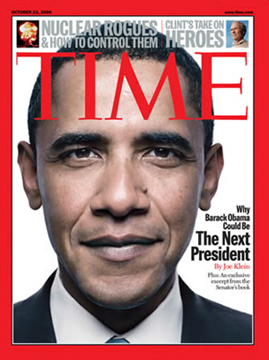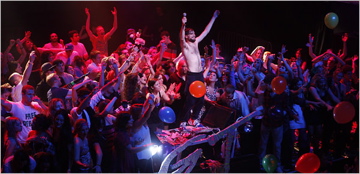What follows is just a bit late for the inauguration, which is appropriate. It is essentially old news.
Let’s start with the “Flash Points” question of the week: how can art effect political change? I worry that this question is a bit loaded. Ordinarily useless and “unreal” art is placed in a subservient position to political “reality,” which demands use value from cultural production. Art has to “do” something for politics; it has to serve the political. But one finds that the political “does” politics much more directly and efficiently than art. Thus the question is whether we can take art and aesthetic experience on their own terms, as valuable in themselves. I am not arguing for a conservative notion of “art for art’s sake,” but a more paradoxical proposal: art’s political contribution is found in art itself, in art’s ways and means. So, to rephrase the question: what does art do with politics, or alongside politics? What is its value as a parallel practice that perhaps intersects but never fully becomes politics (at which point it would cease to be art)?
These are big questions, and I’ll spare you their exhaustive discussion within art history and criticism. Instead, I offer an example that I see as relevant to the present shift in American politics. At a Girl Talk concert at Terminal 5 on November 16, 2008, an image of Barack Obama on the cover of Time magazine was insistently and repeatedly projected on a screen behind the performance. This was more, I contend, than a crowd-pleasing gimmick a little more than a week after the euphoric outcome of the presidential elections. Girl Talk, a.k.a. Greg Gillis, was connecting his form—that of his music and performances—with that of our new political world, and its leader.
Terms for a debate over the canonization of postwar intersections of music and art are now coming into view. On the side of an interdisciplinary redefinition of “high” art is Branden Joseph’s recent book, Beyond the Dream Syndicate: Tony Conrad and the Arts after Cage (A “Minor” History), which positions the artist, filmmaker, and musician Conrad as a profoundly influential figure in postwar cultural production, albeit one who kept a quite consciously low profile to avoid assimilation into late-capitalist “spectacle.” Joseph’s approach represents the austere side of the debate in privileging works of art that look critically at their own means of production, and in the process unveils a wealth of relatively overlooked collaborations between artists and musicians. The effect of this text has been swift; Conrad is featured in MoMA’s latest reconfiguration of its contemporary collection.
Conrad, along with his frequent collaborator Tony Oursler, also appeared in Sympathy for the Devil: Art and Rock and Roll Since 1967, an exhibition of collaboration between artists and musicians and art-about-music curated by Dominic Molon, that recently ended its run at the Musee d’Art Contemporain in Montreal after opening at the Museum of Contemporary Art in Chicago last year. In contrast to Joseph, the curators’ understanding of appropriate material here was far more democratic (although it was an conspicuously white selection of musicians, lascivious Funkadelic posters notwithstanding), ranging from promotional posters and album covers designed by artists to Dan Graham’s video Rock My Religion, from art star Christian Marclay’s use of records and record covers as materials to the ‘zine production of Throbbing Gristle in the 1970s, which bears a striking incorporation of conceptual art’s design and humor. Molon gave equal time to both experimental and popular music, treating both as fair game for artists.
If Joseph relies on the caché of the “experimental” to separate Conrad out from a crowd of interlopers between art and other fields of cultural production, Molon places his faith in the interruption, through aesthetic contemplation and the creation of a “work,” of the immediacy or myth that allows popular music to operate and dominate consumer taste. Art (or the figure or imagined intellect of the artist) mediates, as “not-music,” between music and the listener. Both projects speak to the staggering volume of material that is only beginning to be unearthed in the interstice between contemporary art and music.
Within these coordinates, Girl Talk presents a “problem.” He is an increasingly popular figure (the categories of “musician,” “DJ,” or “artist” do not quite fit) who uses avant-garde aesthetics to produce highly accessible music and a mode of performance grounded in ecstatic and collective immediacy. In short, he enters the forbidden territory of “fun” anathema to many cultural critics, for whom all forms of leisure are mere complicity with the overarching capitalist machine.
Girl Talk first appeared as a “laptop artist” in 2000, using a computer to create manipulations of popular song fragments mixed with noise. As late as his appearance at the CMJ Festival in New York in 2006, he would sing along to dissonant alterations of these sounds, but soon after he refined his project to exclusively combining elements (isolated vocals, drum beats, guitar riffs) of highly recognizable radio hits—hip-hop, 80s, classic rock, and so on—that is characteristic of the “mashup” approach to DJing. This approach has characterized his two most recent records, Night Ripper and Feed the Animals, which have brought him considerable fame and attention. The ultimate effect is a combination of two or more immediately recognizable samples, as in “Smash Your Head,” a track from Night Ripper that combines a Nirvana drumbeat, a speeded-up Elton John vocal and a Biggie Smalls verse (listen below at the 1:30 mark):
[youtube:https://www.youtube.com/watch?v=iDDdpxEf9hM]
Of course, Gillis is not the first to appropriate, in a conspicuous manner, the production of others; this practice has a massive history far beyond the scope of this post. The use of “found” materials—not constructed by the artist but purchased or acquired fully made—in art goes back to Cubist collage and Dada; the usage of found recordings goes back as far as the audiotape experiments of John Cage, musique concrète, minimalism, and Brian Eno; and, in popular music, by dub reggae and early hip-hop producers. The deliberately pirated use of licensed pop songs also dates back in some cases to artist and experimental music collectives, among them Plunderphonics, Negativland and the Evolution Control Committee. This interview with Pitchfork Music discusses a number of Girl Talk’s immediate influences.
Other artists have at times effectively straddled the worlds of art and popular music. In the early 1980s, for example, Laurie Anderson famously “crossed over” with her album Big Science, fusing synthesizer-based experimental pop with performances and music videos that incorporated ideas circulating in conceptual and video art circles and the Pictures generation of New York-based artists.
[youtube:https://www.youtube.com/watch?v=y3YTzt9bQTk]
Girl Talk, however, enjoys a significantly different level of popularity and dissemination, thanks in part to video-sharing websites like YouTube, where there are dozens of homemade videos of songs from the albums and footage of concerts such as this one:
[youtube:https://www.youtube.com/watch?v=wmd4ewFWKVI]
Spliced from successive moments of his concert at Webster Hall in New York on September 15, 2007, this footage is a good example of Girl Talk’s simple performance idea of allowing his fans to do the performing. As has become customary at his shows, the frenzied crowd gradually takes over the stage, spilling in around Gillis as he tinkers with different pieces of songs on his laptop. By the end it is as though he has been swallowed up by the audience, in a quite literal disappearance of the author.
I hope this serves as a sufficient introduction. In Part 2, I will go a bit deeper into Girl Talk’s performance aesthetics and their connection with our newly inaugurated president.






Pingback: Obama Special, Part 2 | Art21 Blog